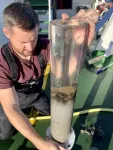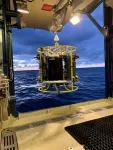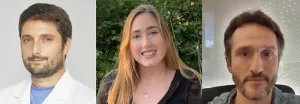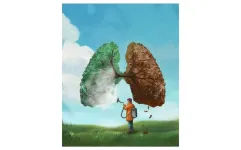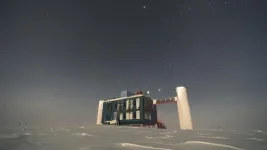(Press-News.org) Woods Hole, Mass. (May 2, 2024) -- Human activities account for a substantial amount - anywhere from 20% to more than 60% - of toxic thallium that has entered the Baltic Sea over the past 80 years, according to new research by scientists affiliated with the Woods Hole Oceanographic Institution (WHOI) and other institutions.
Currently, the amount of thallium (element symbol TI), which is considered the most toxic metal for mammals, remains low in Baltic seawater. However, the research suggests that the amount of thallium could increase due to further anthropogenic, or human induced, activities, or due to natural or human re-oxygenation of the Baltic that could make the sea less sulfide rich. Much of the thallium in the Baltic Sea, the largest human-induced hypoxic area on Earth, accumulates in the sediment thanks to abundant sulfide minerals.
“Anthropogenic activities release considerable amounts of toxic thallium annually. This study evidences an increase in the amount of thallium delivered by anthropogenic sources to the Baltic Sea since approximately 1947,” according to the journal article, “Anthropogenic forcing of the Baltic Sea thallium cycle,” published in Environmental Science & Technology.
“Humans are releasing a lot of thallium into the Baltic Sea, and people should be made aware of that. If this continues – or if we further change the chemistry of the Baltic Sea in the future or if it naturally changes – then more thallium could accumulate. That would be of concern because of its toxicity,” said Chadlin Ostrander lead author of the article, which he conducted as a postdoctoral investigator in WHOI’s Department of Marine Chemistry and Geochemistry. Currently, he is an assistant professor in the Department of Geology & Geophysics at the University of Utah.
For the study, the researchers set out to better understand how thallium and its two stable isotopes 203Tl and 205Tl are cycled in the Baltic Sea. To discern modern thallium cycling, concentration and isotope ratio data were collected from seawater and shallow sediment core samples. To reconstruct thallium cycling further back in time, the researchers supplemented their short core samples with a longer sediment core that had been collected earlier near one of the deepest parts of the sea. They found Baltic seawater to be considerably more enriched in 205Tl than predicted. This enrichment started around 1940 to 1947 according to the longer sediment core.
It would be “highly coincidental” if the 205Tl increase was not associated with the “nearly contemporaneous trends linked to anthropogenic activities,” the article states. Though the exact sources of the thallium increase are not yet known, the article indicates that regional cement production, which was enhanced after the end of World War II, may play an important role, with other possible sources including coal combustion and the roasting of pyrite, an iron sulfide.
“For me, the most important aspect of the study is that we basically discovered that large portions – if not most – of the Baltic Sea are contaminated with the toxic metal thallium from human activities surrounding the basin,” said co-author Sune Nielsen, an adjunct scientist in WHOI’s Department of Geology & Geophysics. “As far as I am aware, this constitutes the geographically most extensive area of thallium contamination ever documented. It has long been known that the Baltic Sea has been strongly affected by anthropogenic activity, not least via the increasingly persistent loss of oxygen that has led to big losses for the fishing industry over the last several decades. As a Danish national, I follow the (bad) news about the Baltic in the Danish media, and our finding just adds another dimension to the already poor conditions in the basin for marine life. While thallium contamination may not be the most immediate concern for the Baltic Sea ecosystem, there is no doubt in my mind that it adds to the urgency of needing to do something to bring the Baltic Sea back to a state where humans and marine life can co-exist naturally.”
“Our data strengthens evidence that the removal of thallium from seawater and storage within sediments is tightly controlled by the absence of oxygen and presence of sulfide,” said co-author Colleen Hansel, a senior scientist in WHOI’s Department of Marine Chemistry and Geochemistry. “It is therefore concerning that recent movements to ‘solve the anoxia problem’ in the Baltic Sea involve pumping oxygen into the bottom waters. This oxygenation of the Baltic will likely lead to the release of thallium, as well as other sulfide-hosted metals like mercury, into the overlying seawater where they could bioaccumulate to toxic levels in fish. We predict, based on activities in the region, that the source of the thallium pollution is historic cement production in the region. As cement production continues to rise globally, this research could serve to caution manufacturers about the need to mitigate potential downstream effects of cement kiln dust on surrounding aquatic and marine ecosystems. This study highlights the utility of isotopes in identifying sources of pollutants to marine ecosystems, which is difficult to disentangle with concentration data alone.”
Funding for this research was provided by the U.S. National Science Foundation and by the Leibniz Association.
Authors: Chadlin M. Ostrander1,2,†,*, Yunchao Shu2,3,††, Sune G. Nielsen2,3,†††, Olaf Dellwig4, Jerzy Blusztajn2,3, Heide N. Schulz-Vogt5, Vera Hübner6, Colleen M. Hansel2
Affiliations:
1Department of Marine Chemistry & Geochemistry, Woods Hole Oceanographic Institution, Woods Hole, Massachusetts, USA
2NIRVANA Laboratories, Woods Hole Oceanographic Institution, Woods Hole, Massachusetts, USA
3Department of Geology & Geophysics, Woods Hole Oceanographic Institution, Woods Hole, Massachusetts, USA
4Department of Marine Geology, Leibniz Institute for Baltic Sea Research Warnemünde, IOW, Rostock, Germany
5Department of Biological Oceanography, Leibniz Institute for Baltic Sea Research Warnemünde, IOW, Rostock, Germany
6Microsensor group, Max Planck Institute for Marine Microbiology, Bremen, Germany
†Now at Department of Geology & Geophysics, University of Utah, Salt Lake City, Utah, USA
††Now at Department of Earth Sciences, University of Hong Kong, Pokfulam, Hong Kong
†††Now at CRPG, CNRS, Université de Lorraine, 54500 Nancy, France
* Corresponding author
About Woods Hole Oceanographic Institution
The Woods Hole Oceanographic Institution (WHOI) is a private, non-profit organization on Cape Cod, Massachusetts, dedicated to marine research, engineering, and higher education. Established in 1930, its primary mission is to understand the ocean and its interaction with the Earth as a whole, and to communicate an understanding of the ocean’s role in the changing global environment. WHOI’s pioneering discoveries stem from an ideal combination of science and engineering—one that has made it one of the most trusted and technically advanced leaders in basic and applied ocean research and exploration anywhere. WHOI is known for its multidisciplinary approach, superior ship operations, and unparalleled deep-sea robotics capabilities. We play a leading role in ocean observation and operate the most extensive suite of data-gathering platforms in the world. Top scientists, engineers, and students collaborate on more than 800 concurrent projects worldwide—both above and below the waves—pushing the boundaries of knowledge and possibility. For more information, please visit www.whoi.edu
[RS1]EDIT NOTE: Journal article lead author Chad Ostrander has provided the URL (hyperlinked here) for the forthcoming published article.
END
Human activity is causing toxic thallium to enter the Baltic sea, according to new study
2024-05-02
ELSE PRESS RELEASES FROM THIS DATE:
NREL proof of concept shows path to easier recycling of solar modules
2024-05-02
The use of femtosecond lasers to form glass-to-glass welds for solar modules would make the panels easier to recycle, according to a proof-of-concept study conducted by researchers at the U.S. Department of Energy’s National Renewable Energy Laboratory (NREL).
The welds would eliminate the need for plastic polymer sheets that are now laminated into solar modules but make recycling more difficult. At the end of their useful lifespan, the modules made with the laser welds can be shattered. The glass and metal wires running through the solar cells can be easily recycled and the silicon ...
NREL invites robots to help make wind turbine blades
2024-05-02
Researchers at the U.S. Department of Energy’s National Renewable Energy Laboratory (NREL) have successfully leveraged robotic assistance in the manufacture of wind turbine blades, allowing for the elimination of difficult working conditions for humans and the potential to improve the consistency of the product.
Although robots have been used by the wind energy industry to paint and polish blades, automation has not been widely adopted. Research at the laboratory demonstrates the ability of a robot to trim, grind, and sand blades. Those necessary steps occur after the two sides of the blade are made using a mold ...
Scent sells – but the right picture titillates both eyes and nose, research finds
2024-05-02
Scented products with relevant images on their packaging and branding, such as flowers or fruit, are more attractive to potential customers and score better in produce evaluations, new research confirms.
And such images, the researchers conclude, are particularly effective if manufacturers and marketers choose pictures that are more likely to stimulate a stronger sense of the imagined smell – for example, cut rather than whole lemons. This, they say, suggests that as well as seducing our eyes, the images are stimulating our sense of smell.
The study, published online in the International Journal of Research in Marketing, could provide manufacturers and marketers ...
Low intensity light to fight the effects of chronic stress
2024-05-02
Some neurological disorders can be improved through photobiomodulation, a non-invasive technique based on the application of low-intensity light to stimulate altered functions in specific regions of the body. Now, a study published in the Journal of Affective Disorders reveals how photobiomodulation applied to the brain-gut axis is effective in recovering some cognitive alterations and sequelae caused by chronic stress. The study opens up new perspectives for applying the technique in future therapies for the treatment of neurological diseases in patients.
The article, based on the study of laboratory animal models, ...
Wildfires in wet African forests have doubled in recent decades
2024-05-02
American Geophysical Union
Press Release 24-19
2 May 2024
For Immediate Release
This press release is available online at: https://news.agu.org/press-release/africa-forest-fires-doubled-drying
Wildfires in wet African forests have doubled in recent decades
Climate change and human activities like deforestation are causing more fires in central and west Africa’s wet, tropical forests, according to the first-ever comprehensive survey there. The fires have long been overlooked.
AGU press contact:
Rebecca Dzombak, news@agu.org (UTC-4 hours)
Contact information ...
Dietary changes may treat pulmonary hypertension
2024-05-02
Blood vessels in the lungs aren’t like the others in the body. This difference becomes clear in pulmonary hypertension, in which only the lungs’ blood vessels stiffen progressively, leading to chronic lung disease, heart failure and death. The underlying reasons for this organ-specific vessel stiffening remained a mystery until University of Pittsburgh researcher Stephen Chan and colleagues made a surprising discovery about these blood vessel cells in patients with pulmonary hypertension—they’re hungry.
Chan, Vitalant Chair in Vascular Medicine and Professor of Medicine in the Division ...
UTA scientists test for quantum nature of gravity
2024-05-02
Einstein’s theory of general relativity explains that gravity is caused by a curvature of the directions of space and time. The most familiar manifestation of this is the Earth’s gravity, which keeps us on the ground and explains why balls fall to the floor and individuals have weight when stepping on a scale.
In the field of high-energy physics, on the other hand, scientists study tiny invisible objects that obey the laws of quantum mechanics—characterized by random fluctuations that create ...
SCAI announces recipients of 2024 early career research grants
2024-05-02
Today, the Society for Cardiovascular Angiography & Interventions (SCAI) announced the recipients of the 3rd Annual SCAI Early Career Research Grants. SCAI offers this initiative to support the next generation of interventional cardiologists, providing a platform for junior-level investigators within 10 years of completing an interventional cardiology fellowship to study high-priority, clinically important topics and have their findings disseminated through various professional channels. This year’s grants are funded by support from Edwards Lifesciences, Medtronic, and Shockwave Medical.
“Research funding is often ...
AI can tell if a patient battling cancer needs mental health support
2024-05-02
Researchers at UBC and BC Cancer have developed a new artificial intelligence (AI) model that can accurately predict if a person receiving cancer care will require mental health services during their treatment journey.
The AI uses natural language processing and advanced neural networks to analyze an oncologist’s notes from their first consultation appointment with a patient. While these appointments are typically highly focused on a patient’s medical history and treatment options, the AI picks ...
ISSCR announces Hong Kong, SAR as location for its 2025 Annual Meeting
2024-05-02
The world’s leading stem cell scientists will convene in Hong Kong, SAR, 11-14 June 2025 for the International Society for Stem Cell Research (ISSCR) 2025 Annual Meeting, illuminating the future of stem cell science and highlighting the most compelling research and clinical advances of the year. The meeting is co-sponsored by The University of Hong Kong, The Chinese University of Hong Kong, and Hong Kong University of Science and Technology. The Hong Kong Innovation and Technology Commission and the Hong Kong Convention and Exhibition Centre provided significant support to enable the ISSCR to bring its hallmark event to the city of ...
